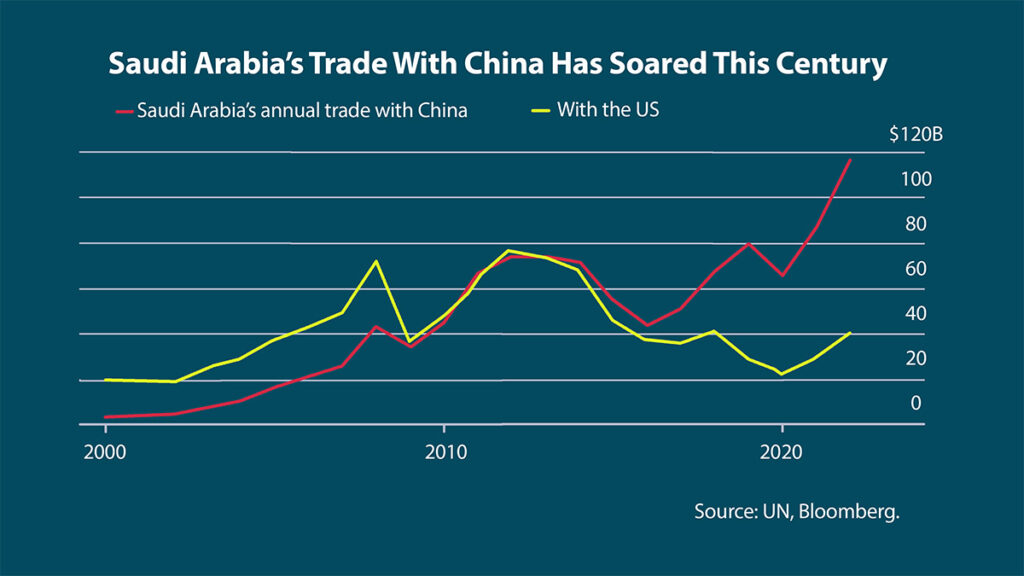For half a century, the petrodollar system has been the bedrock of the dollar’s dominance. This week, that decades-strong foundation appears to have been shattered with reports that Saudi Arabia will start accepting other currencies for petroleum sales.
In this week’s The Gold Spot, Scottsdale Bullion & Coin Sr. Precious Metals Advisor Damian White and Precious Metals Advisor Todd Graf explore this potential rift in US-Saudi relations, its possible implications for the US dollar, and how everyday investors might be impacted.
The Birth of the Petrodollar
Most Americans aren’t familiar with the petrodollar, but they’ve significantly benefitted from the system. In the throes of the 1970s stagflation, countries were actively turning to gold as the dollar’s value suffered. To maintain the dollar’s prominence after the end of the gold standard, President Richard Nixon struck a deal with the Saudi monarchs. Interestingly, there’s no formal agreement or contract. Rather, it’s an arrangement that became solidified into practice over time.
In exchange for US military support, the oil-rich nation would only trade petroleum in US dollars. As long as countries needed oil, the USD would be in high demand. At least, that was how the petrodollar system worked for 50 years. The original deal was meant to be temporary, but both parties saw it worth their while to uphold it. However, murmurings in the media this week suggest this agreement might be over.
The Death of the Petrodollar?
June 9th, 2024, may go down in history as one of the most significant shifts in the world’s monetary system. This week, numerous outlets reported that Crown Prince and Prime Minister Mohammed bin Salman declined to renew the decades-long agreement between Saudi Arabia and the United States. This paradigm-shifting decision would seriously harm the petrodollar and its myriad benefits.

The Petrodollar: A Retrospective
How To Prepare For The Impending Dollar Failure
Get Report – It’s Free!This is the biggest news with the world’s monetary policy in the last 50 years.–
Saudi Arabia Cozies Up to China
Although this reported development could send shockwaves through the world’s financial system, the death of the petrodollar wasn’t a complete surprise. Saudi Arabia’s decision to join the expanding BRICS consortium signaled the country’s interest in moving away from reliance on USD. The entire BRICS cohort is spearheading the global process of de-dollarization as these emerging economies seek independence from US influence.
Since the early 2010s, Saudi Arabia has reduced trade with the US while ramping up relations with China. Now, the Kingdom’s trade with the CCP is nearly four times the size of its dealings with America.

With the potential end of the petrodollar, the rise of the petroyuan is seemingly imminent. If Saudi Arabia allows China to trade oil in its domestic currency, the strength of the yuan will rise. The Kingdom’s recent overtures to the CCP add some weight to the rumors of bin Salman’s possible nixing of the deal.
The Consequences of a Post-Petrodollar World
The fallout from a post-petrodollar economic system could be extensive. Although these reports remain speculative and unconfirmed (as of writing this), the possibility has sparked considerable discussion. If the petrodollar system were to unravel, it could knock the dollar from its position as the world reserve currency.
Here are some potential consequences experts would see unraveling if the petrodollar were to fall:
Less Influence in the Middle East
A crucial part of the alleged deal between the US and Saudi Arabia was the tolerance of American military bases within the Kingdom. This special relationship would enter limbo if this arrangement were to no longer be honored. US influence in the entire region would suffer as a result.
Decreased Usage of the Dollar
As a leading petroleum producer, Saudi Arabia’s exclusive acceptance of USD for oil exports sustained huge dollar demand. If countries could purchase in domestic currencies, it stands to reason the US dollar would see decreased circulation.
Inflation & Dollar Devaluation
With lower greenback demand, dollars would start flowing back to the United States. This rapid influx of USD could create inflation and dollar devaluation. Investors might see decreased buying power, reduced savings, and damaged nest eggs.
A Rush to Gold & Hard Assets
With reports suggesting the end of the petrodollar system, the gold rush is only heating up. Over the past few years, central banks have scooped up record amounts of gold. For example, China has raked in hundreds of tons of gold while shedding US treasuries. The flip side of every move away from the dollar is a shift towards the yellow metal. Savvy investors are following the moves of central banks by increasing their physical gold holdings.
“Nobody on the planet currently owns enough hard assets to protect...their savings and...their purchasing power.”
Learn More About the Petrodollar System
The petrodollar is a main character in the story of US economic dominance. Understanding the history of this system puts current events into perspective and equips investors with key insights for the future.
We’ve compiled an in-depth Petrodollar Report to help investors grasp these crucial developments. This guide covers the backdrop and development of the petrodollar system and its impact on USD.

The Petrodollar: A Retrospective – How To Prepare For The Impending Dollar Failure
Get Report – It’s Free!
Question or Comments?
If you have any questions about today’s topics or want to see us discuss something specific in a future The Gold Spot episode, please add them here.
Comment



Questions or Comments?
"*" indicates required fields